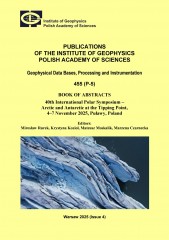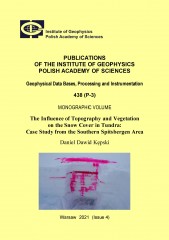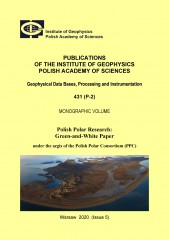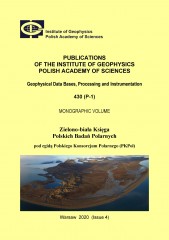BROWSE - VOLUME LIST
- A - Physics of the Earth's Interior
- B - Seismology
-
C - Geomagnetism
C-119, C-118, C-117, C-116, C-115, C-114, C-113, C-112, C-111, C-110, C-109, C-108, C-107, C-106, C-105, C-104, C-103, C-102, C-101, C-100, C-99, C-98, C-97, C-96, C-95, C-94, C-93, C-92, C-91, C-90, C-89, C-88, C-87, C-86, C-85, C-84, C-83, C-82, C-81, C-80, C-79, C-78, C-77, C-76, C-75, C-74, C-73, C-72, C-71, C-70, C-69, C-68, C-67, C-66, C-65, C-64, C-63, C-62, C-61, C-60, C-59, C-58, C-57, C-56, C-55, C-54, C-53, C-52, C-51, C-50, C-49, C-48, C-47, C-46, C-45, C-44, C-43, C-42, C-41, C-40, C-39, C-38, C-37, C-36, C-35, C-33, C-32, C-31, C-30, C-29, C-28, C-27, C-26, C-25, C-24, C-23, C-22, C-21, C-20, C-19, C-18, C-17, C-16, C-15, C-14, C-13, C-12, C-11, C-10, C-9, C-8, C-7, C-6, C-5, C-4, C-3, C-2, C-1
-
D - Physics of the Atmosphere
D-79, D-78, D-77, D-76, D-75, D-74, D-73, D-72, D-71, D-70, D-69, D-68, D-67, D-66, D-65, D-64, D-63, D-62, D-61, D-60, D-59, D-58, D-57, D-56, D-55, D-54, D-53, D-52, D-51, D-50, D-49, D-48, D-47, D-46, D-44, D-45, D-43, D-42, D-41, D-40, D-39, D-38, D-37, D-35, D-34, D-33, D-32, D-31, D-30, D-28, D-27, D-26, D-25, D-24, D-23, D-22, D-21, D-20, D-19, D-18, D-17, D-16, D-15, D-14, D-13, D-12, D-11, D-10, D-9, D-8, D-7, D-6, D-5, D-4, D-3, D-2, D-1
- E - Hydrology
- P - Polar Research
- M - Miscellanea
-
Online First
P - Polar Research
BOOK OF ABSTRACTS. 40th International Polar Symposium – Arctic and Antarctic at the Tipping Point, 4–7 November 2025, Puławy, Poland
Editor(s): Rurek M., Kozioł K., Moskalik M., Czarnecka M.
Volume: 455
Series: P-5
DOI: 10.25171/InstGeoph_PAS_Publs-2025-067
Volume: 455
Series: P-5
DOI: 10.25171/InstGeoph_PAS_Publs-2025-067
The Polar Symposium is a recurrent conference, typically occurring every two years, dedicated to Arctic and Antarctic topics, with a long tradition dating back to 1972. Since then, these meetings have been an excellent opportunity for integrating the polar community, exchanging experiences, and a discussion between Polish and international polar researchers representing various scientific disciplines. The Polar Symposium is currently co-organised by the Committee of Polar Research, Polish Academy of Sciences, and the Polish Polar Consortium, and until recently it has also been co-organised by the Polar Club of the Polish Geographical Society. Instead, during the 40th International Polar Symposium, a new Polish Polar Club will debut as an independent association, thus continuing the functioning of the Club since 1974.
SVALGEOBASE II: Tectono-thermal Evolution of Svalbard – from Metamorphic and Magmatic Processes to Geothermal Energy. Geological Workshop, Svalbard, 3–9 September 2024
Editor(s): Michalski K., Majka J., Głowacki P., Augland L., Manby G.M., Piepjohn K. ., Guarnieri P., Senger K. .
Volume: 452
Series: P-4
DOI: 10.25171/InstGeoph_PAS_Publs-2025-001
Volume: 452
Series: P-4
DOI: 10.25171/InstGeoph_PAS_Publs-2025-001
We are pleased to present the report from the second edition of the geological workshop SvalGeoBase II, titled “Tectono-thermal evolution of Svalbard – from metamorphic and mag-matic processes to geothermal energy”. Held from September 3 to 9, 2024, in Svalbard, this event continued the legacy of the first edition, SvalGeoBase I, organized in 2013 under the theme “Proterozoic and Lower Palaeozoic basement of Svalbard – state of knowledge and new research perspectives”.
The Influence of Topography and Vegetation on the Snow Cover in Tundra: Case Study from the Southern Spitsbergen Area
Author(s): Kępski D.
Volume: 438
Series: P-3
DOI: 10.25171/InstGeoph_PAS_Publs-2021-041
Volume: 438
Series: P-3
DOI: 10.25171/InstGeoph_PAS_Publs-2021-041
The aim of the study was to identify the snow cover distribution in the southern Spitsbergen tundra environment and to quantify its relationship with the topography and land cover. This was achieved by correlating vectorized cartographic materials, modeled climatic parameters and calculated topographic indices with snow cover properties measured in the field and obtained using remote sensing techniques. An important source of information used in the analyzes was time-lapse photography, which, thanks to the developed methodology and created tools, allowed to obtain snow cover extent data characterized by high temporal and spatial resolution. Snow cover distribution in the immediate vicinity of the Polish Polar Station obtained from time-lapse material was related to the results of satellite image classification from the 2014 ablation season.
Polish Polar Research: Green-and-White Paper under the aegis of the Polish Polar Consortium (PPC)
Author(s): Lewandowski M., Polkowska Z., Ziaja W., et al .
Volume: 431
Series: P-2
DOI: 10.25171/InstGeoph_PAS_Publs-2020-006
Volume: 431
Series: P-2
DOI: 10.25171/InstGeoph_PAS_Publs-2020-006
The aim of this document is to present the current state of Polish research in the polar areas, as well as to suggest the main directions for further development of this research, taking into account its educational and cognitive importance and its social and economic utility. The book is addressed to the state administration and the scientific communities in Poland, those already engaged in polar studies as well as those seeking new openings in their current research. The book should also be a starting point for updating the current Polar Research Strategy.
Zielono-biała Księga Polskich Badań Polarnych pod egidą Polskiego Konsorcjum Polarnego (PKPol)
Author(s): Lewandowski M., Polkowska Z., Ziaja W., et al .
Volume: 430
Series: P-1
DOI: 10.25171/InstGeoph_PAS_Publs-2020-005
Volume: 430
Series: P-1
DOI: 10.25171/InstGeoph_PAS_Publs-2020-005
Niniejsze opracowanie ma na celu przedstawienie aktualnego stanu polskich badań przyrodniczych, prowadzonych w obszarach polarnych, a także zasugerowanie głównych kierunków rozwoju tych badań w Polsce, z uwzględnieniem ich znaczenia edukacyjno-poznawczego oraz społecznej i ekonomicznej użyteczności. Adresatami Księgi są zainteresowane problematyką jednostki administracji państwowej oraz środowisko naukowe w Polsce, zarówno polarne jak i poszukujące nowego otwarcia w swojej działalności badawczej. Księga powinna także stanowić punkt wyjścia dla aktualizacji obecnej Strategii Badań Polarnych.






